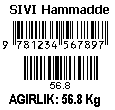Product Barcoding and Barcode Types
Without product barcoding, the points of sale of the product and how it is sold and the methods used in product tracking are important.
If your product is a retail product, such as biscuits, cigarettes, detergents, beverages, etc., it is recommended to use EAN barcoding. In this way, you will have a code that belongs only to your organization. EAN coding is explained in the Barcode Types section.
If the product is not retail or if you will only use it to monitor your own stocking and production system, you do not have to use EAN coding. But you can still use EAN for standard coding of your products. With each EAN code from the Commodity Numbering Center, you can code 10,000 products from 0 to 9999. If there are more than 10,000 products, you can obtain a separate EAN code from the Goods Numbering Center.
If you are barcoding products in-house, the commonly used barcode type is Code 39 or Code 128. Barcode codes do not need to be meaningful. Because these codes are a coding system that will be recognized by the computer. The important thing is that each product group, type or type is given a different code to distinguish the products from each other.
The barcode can contain the product code, but it can also be used to print information such as weight, serino, company code on the product. Barcode is used not only on products, but also on warehouse shelf addresses, numbering of production workstations, personnel cards and many other places.
Various label types are shown below:
 |
 |
 |
In the first label example, there is only the product code of the product. With this code, it may be sufficient to access the price information of the product and what the product is. In this coding, the price information of the product and what the product is are not written. However, the information corresponding to this code is retrieved by your computer from the database and processed.
In the second label example, there is a product barcode and a serial number of the product. The serial number is usually used to track the product individually. Each serial numbered product can usually be tracked separately. For example, when the Monitor indicated on the label arrives at the Technical Service, the serial number of the product can be used to determine when the product was sold and whether it is under warranty. This information corresponds to the serial number on the computer. The serial number is a different number for each product and does not include when the product was sold or the warranty period. The serial number does not necessarily contain this information. But you can still include information such as the production date of the product in the barcode information.
Another example is labeling for products that do not have a standard quantity. Again, there is a product barcode on the label and a weight barcode just below it. In this way, weight information can be written on each of the products with variable weights.
Occasionally, some product-specific information can be written on a single barcode, such as both the code and the weight of the product. The advantage of this is that you can access the product code and the weight information of the product with a single barcode scanning process.

This Post Has 0 Comments